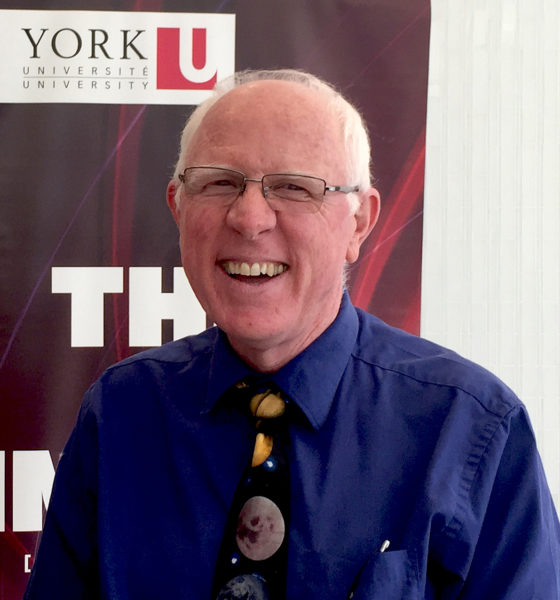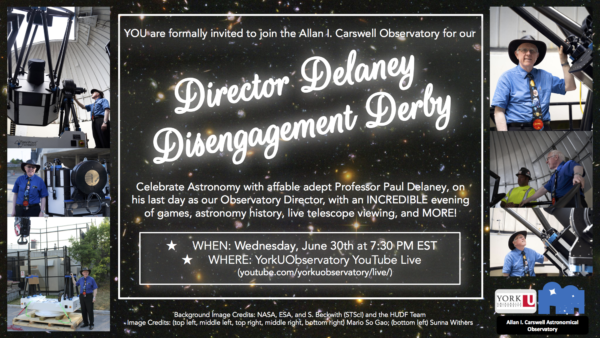Professor Paul Delaney answers this and otherworldly questions before boarding his spaceship to places unknown
TORONTO, June 28, 2021 – As York University physics and astronomy Professor Paul Delaney gets ready to board his spaceship and fly off (retire), he is leaving behind a few answers to some of the public’s most common astronomical questions over the years.
 Delaney is the inaugural Allan I. Carswell Chair for the Public Understanding of Astronomy in the Faculty of Science and has been at York since September 1986. He has been the public face of astronomy for York for many years teaching undergraduate and graduate students, but also thousands of elementary students and the community through science outreach events and in the observatory.
Delaney is the inaugural Allan I. Carswell Chair for the Public Understanding of Astronomy in the Faculty of Science and has been at York since September 1986. He has been the public face of astronomy for York for many years teaching undergraduate and graduate students, but also thousands of elementary students and the community through science outreach events and in the observatory.
In addition to answers to popular questions, Delaney is available to answer otherworldly questions from media. The public will have the opportunity to do the same during his farewell YouTube disengagement derby (details below).
- Will Earth be swallowed by a black hole? Absolutely not. While a black hole does have an immense gravitational field, they are only “dangerous” if you get very close to them. For example, if our own sun was to (miraculously) transform into a black hole of the same mass, our planet would not discern any change in the gravitational force acting on it and continue in the same orbit. It would get very dark of course and very cold, but the black hole’s gravity at our distance from it would not be a concern.
- Is there life on other planets? We really do not know the answer to this question. Astronomers are searching for this answer in a number of ways, but at present, we can only say that life exists on Earth. My opinion is that life is common, and that we will find evidence of life on other planets in the relatively near future. There is an enormous amount of “real estate” (exoplanets) in our own Milky Way galaxy and based on our understanding of the way life developed in our solar system, I would expect similar conditions to have existed on other planets too.
- Will the sun become a supernova? No, our sun will end up as a red giant followed by a white dwarf. The death of our sun, about five to six-billion years from now, will be a relatively calm affair compared to the destructive demise of star that goes supernova. It is a question of mass that determines the way a star completes its life cycle. Our sun is too low in mass to allow the supernova process to occur.
- Do you want to go into space? Absolutely but unfortunately, I am now too old to do so. I have always wanted the opportunity to see Earth from space, to experience weightlessness and to observe the stars from a vantage point other than the ground. With humanity on the cusp of space tourism, I expect my grandchildren will have the opportunity to “weekend” or “camp” in Earth orbit or even go to the Moon for a holiday. Sadly, I was born too early in the Space Age.
- Why does the moon look bigger when it’s close to the horizon? The moon fascinates people. The moon illusion, the idea that the moon is actually bigger when viewed near the horizon is a common misconception. The apparent angular size of the moon does not change during the night. It appears larger at moonrise or moonset simply because the observer sees the moon proximate to familiar objects like trees, houses, etc., and your mind interprets the moon to be “bigger.” When the moon is higher in the sky, there are no familiar reference points, just the open, vastness of space and again, your mind interprets the moon to be “smaller.”
- When is it a good time to observe? Anytime! The stars are there waiting for anyone to enjoy, with or without a telescope.
YouTube disengagement derby
Join the Allan I. Carswell Observatory’s online YouTube retirement party, An Astronomy 4D Event: The Director Delaney Disengagement Derby, on Wednesday, June 30 at 7:30pm where observatory staff and faculty will answer questions, discuss astronomy, have observations and tell stories. Comments, stories and questions are welcome in advance at eahyde@yorku.ca.
Navigate your way here: https://www.youtube.com/user/YorkUObservatory/live

The York observatory has been a prominent hub for science outreach to the broader community since 1969. In pre-COVID-19 days, about 5,000 visitors annually came for public viewing on Wednesday nights. Hundreds more, especially during the pandemic, tune into Monday night viewing opportunities when York students and faculty host the popular “YorkUniverse” radio show on astronomy.fm online.
After June 30, Delaney will be on sabbatical until he hangs his hat on the nearest star Dec. 31.
-30-
York University is a modern, multi-campus, urban university located in Toronto, Ontario. Backed by a diverse group of students, faculty, staff, alumni and partners, we bring a uniquely global perspective to help solve societal challenges, drive positive change and prepare our students for success. York's fully bilingual Glendon Campus is home to Southern Ontario's Centre of Excellence for French Language and Bilingual Postsecondary Education. York’s campuses in Costa Rica and India offer students exceptional transnational learning opportunities and innovative programs. Together, we can make things right for our communities, our planet, and our future.
Media Contact:
Sandra McLean, York University Media Relations, 416-272-6317, sandramc@yorku.ca

